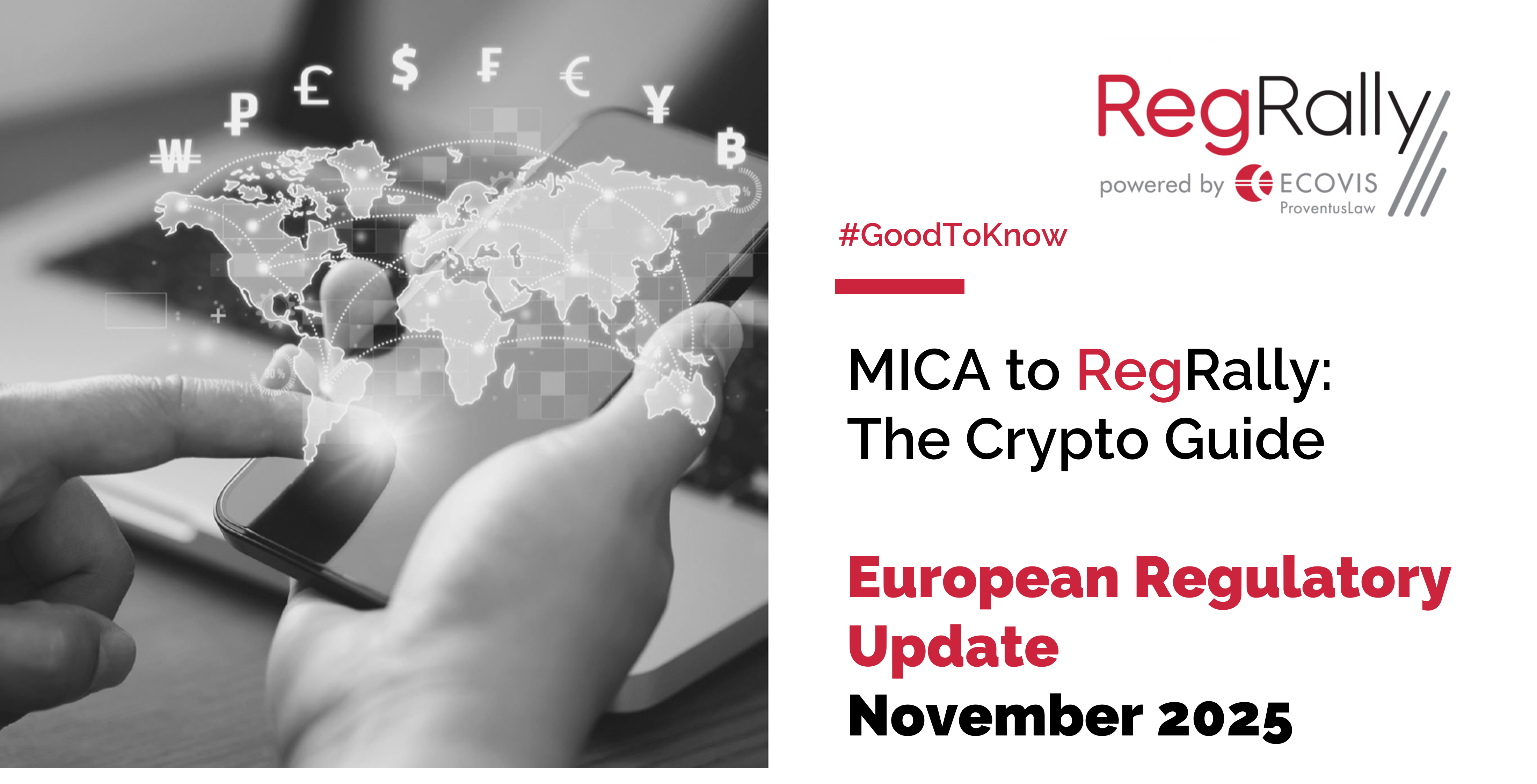In this issue, ECOVIS ProventusLaw presents a curated selection of key developments from the European crypto regulatory landscape in November 2025. It provides viewers with a glimpse into the future and high-profile insights into the ever-evolving crypto industry.
Bank of Lithuania Updates on CASP Licensing: Nearly 50 Applications Filed, Few Meeting Core Requirements
On 27 October 2025, the Bank of Lithuania issued an update on the status of Crypto-Asset Service Provider (CASP) authorisation applications. Since the start of the year, nearly 50 applications have been submitted, with only one licence granted and a small number still under review. The regulator aims to issue decisions on pending applications by the end of the year.
The Bank noted that the most recent submissions have failed to meet foundational requirements, highlighting a lack of preparedness among applicants. It reiterated that firms should assess their readiness carefully before applying, as incomplete or inadequate applications may be rejected outright. The Bank also confirmed that the number of CASP licences expected to be issued this year remains limited.
FSB Peer Review Highlights Regulatory Gaps in Global Crypto and Stablecoin Oversight
On 16 October 2025, the Financial Stability Board (FSB) released the findings of its first peer review on the implementation of its Global Regulatory Framework for Crypto-Asset Activities, covering both CASPs and global stablecoin arrangements (GSCs). While acknowledging progress across jurisdictions, the review identifies significant remaining gaps, particularly in stablecoin oversight, cross-border cooperation, and risk management of financial stability.
Key findings show that comprehensive stablecoin regulation remains limited, with jurisdictions adopting inconsistent frameworks and lacking robust supervisory tools for liquidity management, prudential oversight, and risk reporting. Most regulators remain primarily focused on AML/CFT and consumer protection, leaving broader systemic risks inadequately addressed.
The FSB warns that regulatory fragmentation and inconsistencies may foster regulatory arbitrage, hinder market interoperability, and create potential systemic vulnerabilities in the growing stablecoin sector.
ESRB Warns of Rising Systemic Risks from Stablecoins, Crypto-Investment Products, and Multi-Function Groups
On 20 October 2025, the European Systemic Risk Board (ESRB) issued its 2025 assessment of systemic risks from crypto-assets, highlighting that crypto-related vulnerabilities have evolved into macro-financially relevant concerns. The report focuses on stablecoins, crypto-investment products (CIPs), and multi-function groups (MFGs) that combine issuance, trading, and custody services.
Key observations include the dominance of USD-backed stablecoins, which make up nearly the entire market and expose the EU to U.S. monetary policy spillovers. Multi-issuer stablecoin models – where the same token is issued both inside and outside the EU – create regulatory gaps and raise contagion risks, especially under run scenarios. While MiCA establishes a regulatory baseline, the ESRB notes that it lacks targeted tools to manage cross-border liquidity stress and non-EU issuance structures.
The report also flags the rapid expansion of CIPs, increasing institutional involvement, and the growing complexity of MFGs, which introduce conflicts of interest, governance opacity, and heightened systemic risk potential.
The ESRB further identifies cyber resilience weaknesses among non-EU-linked actors and supports DORA as a baseline framework, calling for enhanced supervisory measures and stronger international coordination to address emerging cross-border risks.
ESMA Clarifies MiCA Obligations for “Legacy” Crypto-Assets Admitted Before 30 December 2024
On 25 September 2025, the European Securities and Markets Authority (ESMA) issued guidance on the treatment of crypto-assets admitted to trading before 30 December 2024 under the MiCA Regulation, commonly referred to as “legacy” tokens. ESMA confirmed that offerors and persons seeking admission to trading for these assets must comply only with MiCA’s marketing communication requirements and are not required to prepare new white papers.
However, operators of crypto-asset trading platforms must ensure that, by 31 December 2027, a MiCA-compliant white paper for each legacy token is prepared, notified, published, and kept up to date. Other CASPs, in line with Article 66(3) MiCA, are only required to provide hyperlinks to any existing registered white papers and are not responsible for drafting new ones. Tokens not listed on trading platforms may remain without a MiCA white paper beyond 2027.
This three-year transition period positions trading platforms as key compliance gatekeepers, allowing them to align documentation and ensure orderly integration of pre-MiCA assets into the new regulatory framework.
Stablecoins May Pose Systemic Risks to the EU, ESRB Warns
The ESRB cautions that stablecoins issued both within and outside the EU could pose a threat to the Union’s financial stability due to regulatory gaps between MiCA-regulated EU issuers and largely unregulated non-EU issuers. “Multi-issuer” structures may create vulnerabilities in market stress scenarios, potentially draining EU-based reserves and increasing pressure on the ECB. The ESRB calls for aligned global rules and urges issuers and intermediaries to reassess cross-border models in anticipation of future EU reforms.
EU FIUs Coordinate on AML/CFT Risks in Crypto Sector Ahead of MiCA Transition
EU financial intelligence units met in Frankfurt to harmonise supervisory approaches for crypto-asset service providers during MiCA’s transitional phase, focusing on standardised oversight, joint analyses, and enhanced cross-border cooperation. Lithuania’s FCIS participated actively and held separate consultations with AMLA leadership to strengthen alignment with upcoming EU-level supervisory practices.


 Newsletter Subscription
Newsletter Subscription